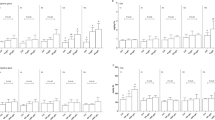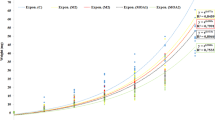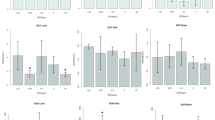Abstract
Global trends in pesticide use can increase aquatic pollution and affect resident fisheries. Crabs exposed to organophosphate pesticides, such as chlorpyrifos, may increase production of reactive oxygen species (ROS), affecting the pro-oxidant/antioxidant balance. Zichiopsis collastinensis crabs were exposed to environmentally relevant concentrations of chlorpyrifos (0.1 and 0.5 µg L−1). Effects on the oxidative stress enzymes catalase, superoxide dismutase, glutathione S-transferases, glutathione reductase, and on thiobarbituric acid reactive substances and hydrogen peroxide concentrations were evaluated at four intervals during 96 h exposures. Exposures caused decreased GST activity and increased H2O2 levels in gills. There were modifications of GST, CAT and SOD activities in the hepatopancreas after 12 h of exposure, and an increase of H2O2 levels at every exposure interval observed. The present study proved that chlorpyrifos lead to oxidative stress in Z. collastinensis. However other enzymatic/non-enzymatic responses should be further investigated in order to be included as part of a battery of biomarkers, together with H2O2 levels, which is a parameter highly recommended to be taken into account.




Similar content being viewed by others

References
Abdalla RP, Kida BMS, Pinheiro JPS, Oliveira LF, Martinez CBF, Moreira RG (2019) Exposure to aluminum, aluminum+ manganese and acid pH triggers different antioxidant responses in gills and liver of Astyanax altiparanae (Teleostei: Characiformes: Characidae) males. Comp Biochem Physiol C 215:33–40
Alvarez M, Du Mortier C, Jaureguiberry S, Venturino A (2019) Joint probabilistic analysis of risk for aquatic species and exceedance frequency for the agricultural use of chlorpyrifos in the Pampean region, Argentina. Environ Toxicol Chem. https://doi.org/10.1002/etc.4441.
ATSDR, Agency for Toxic Substances and Disease Registry (1997) Toxicological profile for chlorpyrifos. ATSDR, Atlanta
Bellincampi D, Dipierro N, Salvi G, Cervone F, De Lorenzo G (2000) Extracellular H2O2 induced by oligogalacturonides is not involved in the inhibition of the auxin-regulated rolB gene expression in tobacco leaf explants. Plant Physiol 122:1379–1385
Bertrand L, Monferrán MV, Mouneyrac C, Bonansea RI, Asis R, Amé MV (2016) Sensitive biomarker response of the shrimp Palaemonetes argentinus exposed to chlorpyrifos at environmental concentrations: roles of alpha-tocopherol and metallothioneins. Aquat Toxicol 179:72–81
Bradford MM (1976) A rapid and sensitive method for the quantification of microgram quantities of protein utilizing the principle of protein-dye binding. Anal Biochem 72:248–254
Claiborne A (1985) Catalase activity. In: Greenwald RA (ed) Book of methods in oxygen radical research. CRC Press, Boca Raton, pp 283–284
Del Rio D, Stewart AJ, Pellegrini N (2005) A review of recent studies on malondialdehyde as toxic molecule and biological marker of oxidative stress. Nutr Metab Cardiovasc Dis 15(4):316–328
Etchegoyen MA, Ronco AE, Almada P, Abelando M, Marino DJ (2017) Occurrence and fate of pesticides in the Argentine stretch of the Paraguay-Paraná basin. Environ Monitor Assess 189:63
Ferrario C, Parolini M, De Felice B, Villa S, Finizio A (2018) Linking sub-individual and supra-individual effects in Daphnia magna exposed to sub-lethal concentration of chlorpyrifos. Environ Pollut 235:411–418
Ghedira J, Jebali J, Bouraoui Z, Banni M, Chouba L, Boussetta H (2009) Acute effects of chlorpyrifos-ethyl and secondary treated effluents on acetylcholinesterase and butyrylcholinesterase activities in Carcinus maenas. J Environ Sci 21:1467–1472
Goncalvez C, Alpendurada MF (2002) Multiresidue method for the simultaneous determination of four groups of pesticides in ground and drinking waters, using solid phase microextraction-gas chromatography with electron-capture and thermionic specific detection. J Chromatogr A 968:177–190
Habig WH, Pabst MJ, Jakoby WB (1974) Glutathione S transferases. The first step in mercapturic acid formation. J Biol Chem 249:7130–7139
Li Y, Zhou F, Huang J, Yang L, Jiang S, Yang Q, He J, Jiang S (2018) Transcriptome reveals involvement of immune defense, oxidative imbalance, and apoptosis in ammonia-stress response of the black tiger shrimp (Penaeus monodon). Fish Shellfish Immunol 83:162–170
Lushchak VI (2011) Environmentally induced oxidative stress in aquatic animals. Aquat Toxicol 101:13–30
Narra MR (2014) Tissue-specific recovery of oxidative and antioxidant effects of chlorpyrifos in the freshwater crab, Barytelphusa guerini. Arch Environ Contam Toxicol 67(2):158–166
Oakes KD, Van Del Kraak GJ (2003) Utility of the TBARS assay in detecting oxidative stress in white sucker (Catostomus commersoni) populations exposed to pulp mill effluent. Aquat Toxicol 63:447–463
Ocampo EH, Menone ML, Iturburu FG, Nuñez JD, Baeza JA (2014) Effect of the endosymbiotic pea crab Calyptraeotheres garthi on the metabolic rate and oxidative status of the slipper limpet Crepidula cachimilla. Invertebr Biol 133(2):170–179
Pan LQ, Zhang HX (2006) Metallothionein, antioxidant enzymes and DNA strand breaks as biomarkers of Cd exposure in a marine crab, Charybdis japonica. Comp Biochem Physiol C 144:67–75
Pham B, Miranda A, Allinson G, Nugegoda D (2017) Evaluating the non-lethal effects of organophosphorus and carbamate insecticides on the yabby (Cherax destructor) using cholinesterase (AChE, BChE), Glutathione S-transferase and ATPase as biomarkers. Ecotox Environ Saf 143:283–288
Pinho GL, Moura da Rosa C, Yunes JS, Luquet CM, Bianchini A, Monserrat JM (2003) Toxic effects of microcystins in the hepatopancreas of the estuarine crab Chasmagnathus granulatus (Decapoda, Grapsidae). Compar Biochem Phisiol C 135:459–468
Scebba F, Sebastiani L, Vitagliano C (1998) Changes in activity of antioxidative enzymes in wheat (Triticum aestivum) seedlings under cold acclimation. Physiol Plantarum 104:147–752
Schulz R (2001) Rainfall-induced sediment and pesticide input from orchard into the Lourens river, Western Cape, South Africa: importance of a single event. Wat Res 35(8):1869–1876
Storey KB (1996) Oxidative stress: animal adaptations in nature. Braz J Med Biol Res 29:1715–1733
Tanaka K, Sano T, Ishizuba K, Kitta K, Kawamura Y (1994) Comparison of properties of leaf and root glutathione reductases from spinach. Physiol Plantarum 91:353–358
Thomaz JM, Martins ND, Monteiro DA, Rantin FT, Kalinin AL (2009) Cardio-respiratory function and oxidative stress biomarkers in Nile tilapia exposed to the organophosphate insecticide trichlorfon (NEGUVON®). Ecotox Environ Saf 72(5):1413–1424
Valavanidis A, Vlahogianni T, Dassenakis M, Scoullos M (2006) Molecular biomarkers of oxidative stress in aquatic organisms in relation to toxic environmental pollutants. Ecotox Environ Saf 64(2):178–189
Van der Oost R, Beyer J, Vermeulen NPE (2003) Fish bioaccumulation and biomarkers in environmental risk assessment: a review. Environ Toxicol Pharmacol 13:57–149
Wiegand C, Pflugmacher S, Oberemm A, Steinberg C (2000) Activity development of selected detoxication enzymes during the ontogenesis of the zebrafish (Danio rerio). Int Rev Hydrobiol 85(4):413–422
Zar JH (1996) Biostatistical analysis. Prentice Hall, New York
Acknowledgements
This study was supported by the Grants PICT 2015 2811 and PICT 2013 1348 (FONCYT); (CAI + D 50020150100035LI (UNL) and EXA 795/16 (UNDMP).
Author information
Authors and Affiliations
Corresponding author
Ethics declarations
Conflict of interest
The authors declare that they have no conflict of interest.
Ethical Approval
All applicable international, national, and/or institutional guidelines for the care and use of animals were followed.
Rights and permissions
About this article
Cite this article
Negro, C.L., Iturburu, F.G., Mendieta, J. et al. Are Oxidative Stress Biomarkers Sensitive to Environmental Concentrations of Chlorpyrifos Exposed to the Freshwater Crab, Zilchiopsis collastinensis (Decapoda; Trichodactylidae)?. Bull Environ Contam Toxicol 103, 405–410 (2019). https://doi.org/10.1007/s00128-019-02643-9
Received:
Accepted:
Published:
Issue Date:
DOI: https://doi.org/10.1007/s00128-019-02643-9



